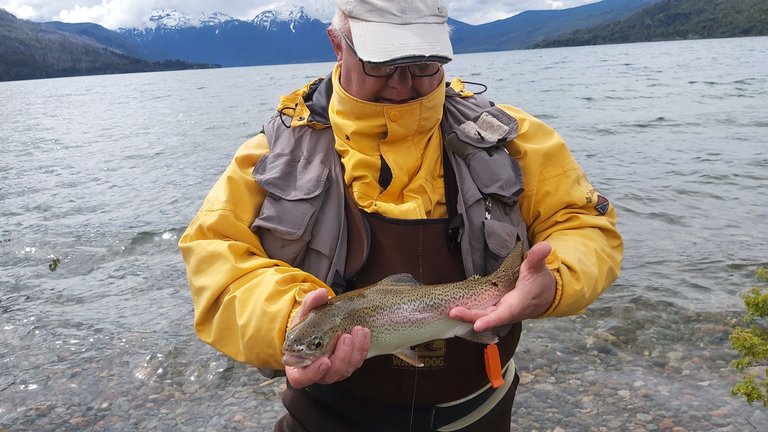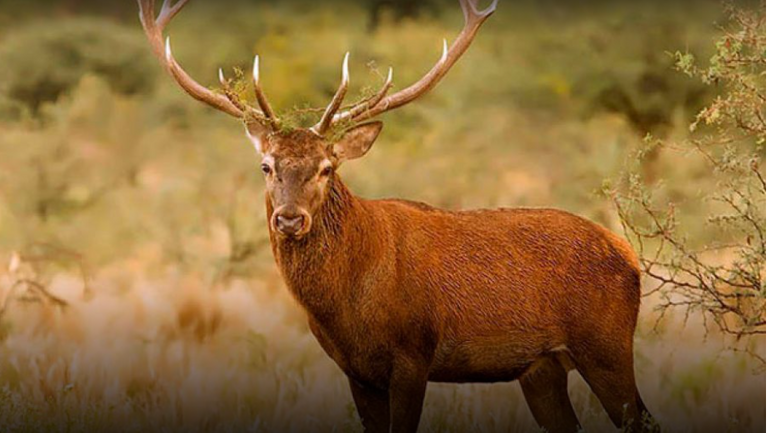Animales exóticos (ESP - ENG)

Al igual que mi amigo @hosgug, me gusta la pesca. La hemos disfrutado juntos prácticamente toda la vida y continuamos haciéndolo cada vez que me visita aquí en Esquel. Es un lugar privilegiado para estas cosas y siempre lo estoy esperando para ir a alguno de los múltiples destinos de pesca que tengo la suerte de disponer por aquí.
Alguien dijo alguna vez que la trucha es un pez que ha sido diseñado para ser pescado con mosca y no le falta razón. Esta modalidad de pesca nació en Inglaterra en el siglo XIII, al menos hay documentación que muestra esa época como la del inicio de una forma de pescar diferente a todo lo conocido, los habitantes de poblaciones cercanas a los ríos observaron que esos peces se alimentaban de insectos que se posaban en la superficie del agua y se les ocurrió tratar de imitarlos disfrazando sus anzuelos con pelos y plumas, habían comprendido que esas delicadas criaturas aladas eran prácticamente imposible de utilizar ensartadas en sus anzuelos.
A principios del siglo XX las truchas y salmones que son originarias del hemisferio norte fueron introducidas en la Patagonia, un ambiente similar al de sus orígenes. Por muchos años pocos recordaron esas siembras de ovas que se llevaron a cabo entre los años 1903 y 1904. Cuando los lugareños y visitantes vieron el tamaño y la cantidad de peces que habían crecido libremente en nuestros ríos y lagos no lo podían creer.
La introducción de animales exóticos en otros ambientes tiene consecuencias, algunas benignas y otras desagradables, peligrosas en determinados casos.
Las truchas han atraído el turismo de la pesca, solamente en Estados Unidos hay más de 8 millones de personas que practican esta modalidad y cada año se venden más permisos de pesca internacionales que locales. Sin embargo su introducción prácticamente ha hecho desaparecer varias especies de peces nativos de la región como los puyenes, el bagre aterciopelado y el bagre de los torrentes. Otros como el pejerrey patagónico y la perca o trucha criolla parecen llevarse mejor con las voraces truchas y salmones.
Pero el mayor impacto de las especies introducidas se ve en los mamíferos, la rata almizclera, nativa de los Estados Unidos ha proliferado fuertemente en la región más austral del país provocando daños en las construcciones, El castor canadiense es nativo de regiones donde los bosques de coníferas y álamos son de rápido crecimiento, aquí se han encontrado con árboles más duros y de crecimiento lento por lo que su actividad natural de construcción de diques que generan inundaciones provoca daños irreparables, un estudio llevado a cabo en Tierra del Fuego ha determinado que existen entre 0,2 y 5,8 colonias de castores por kilómetro cuadrado, en Chile esa cantidad es aun mayor debido a que prácticamente no se los combate. El ciervo colorado es otro mamífero que se ha adaptado rápidamente y el crecimiento de su población es importante aunque se lo caza en forma legal y también furtiva, su impacto negativo es principalmente sobre el ciprés, la única conífera originaria del hemisferio sur. Un animalito simpático, el conejo europeo, fue introducido en el año 1936 y luego de 20 años se calculó en más de 3 millones de ejemplares dispersos por toda la Patagonia, su impacto negativo es sobre los campos de pastoreo del ganado ovino, uno de los principales activos económicos de la región. Por último, el visón americano también es un gran colonizador y depredador de varias especies de aves y peces, antiguamente se utilizaba su piel en peletería pero en la actualidad esa industria está mal considerada y prácticamente no se lo caza con esos fines.

Como se puede observar, la introducción de fauna exótica ha provocado mayores males que beneficios. Seguramente se realizó en tiempos donde algunas variables no eran tenidas en cuenta, hoy en día se piensa mejor que se puede introducir y que no, cuales son los beneficios y perjuicios que puede ocasionar una decisión de este tipo.
Ahora con todas las especies introducidas lo que queda es controlar las poblaciones y minimizar los riesgos de sus conductas.
En otra oportunidad les comentaré sobre otros miembros de la fauna y la flora que coexisten con los nativos en nuestra querida y extensa Patagonia.
Like my friend @hosgug, I like fishing. We have enjoyed it together practically all our lives and we continue to do so every time he visits me here in Esquel. It is a privileged place for these things and I am always waiting for it to go to one of the many fishing destinations that I am lucky to have around here.
Someone once said that trout is a fish that has been designed to be caught with a fly and they are right. This modality of fishing was born in England in the 13th century, at least there is documentation that shows that time as the beginning of a way of fishing different from everything known, the inhabitants of towns near the rivers observed that these fish fed on insects that landed on the surface of the water and it occurred to them to try to imitate them by disguising their hooks with hair and feathers, they had understood that these delicate winged creatures were practically impossible to use strung on their hooks.
At the beginning of the 20th century, trout and salmon that are native to the northern hemisphere were introduced to Patagonia, an environment similar to their origins. For many years, few remembered those egg sowings that took place between 1903 and 1904. When the locals and visitors saw the size and quantity of fish that had grown freely in our rivers and lakes, they could not believe it.
The introduction of exotic animals in other environments has consequences, some benign and others unpleasant, and dangerous in certain cases.
Trout have attracted fishing tourism, in the United States alone there are more than 8 million people who practice this type of fishing and each year more international than local fishing permits are sold. However, its introduction has practically made several species of fish native to the region disappear, such as the puyenes, the velvety catfish, and the torrent catfish. Others, such as the Patagonian silverside and perca or creole trout seem to get along better with the voracious trout and salmon.
But the greatest impact of the introduced species is seen in mammals, the muskrat, native to the United States, has proliferated strongly in the southernmost region of the country, causing damage to buildings, The Canadian beaver is native to areas where the forests of conifers and poplars are fast-growing, here they have found harder and slow-growing trees, so their natural activity of building dykes that cause flooding causes irreparable damage, a study carried out in Tierra del Fuego has determined that there are between 0.2 and 5.8 beaver colonies per square kilometer, in Chile that amount is even higher because they are practically not combated. The red deer is another mammal that has adapted rapidly and its population growth is significant, although it is hunted legally and also poached, its negative impact is mainly on the cypress, the only conifer native to the southern hemisphere. A cute little animal, the European rabbit, was introduced in 1936 and after 20 years it was estimated at more than 3 million specimens scattered throughout Patagonia. Its negative impact is on sheep grazing fields, one of the main economic assets of the region. Lastly, the American mink is also a great colonizer and predator of various species of birds and fish. In the past, its skin was used for fur, but today this industry is poorly regarded and practically not hunted for these purposes.
As can be seen, the introduction of exotic fauna has caused more significant harm than benefits. Surely it was carried out in times when some variables were not taken into account, today it is better thought what can be introduced and what not, and what are the benefits and harms that a decision of this type can cause.
Now with all the introduced species, what remains is to control the populations and minimize the risks of their behaviors.
On another occasion, I will comment on other members of the fauna and flora that coexist with the natives in our beloved and extensive Patagonia.
Congratulations @onlyfly! You have completed the following achievement on the Hive blockchain And have been rewarded with New badge(s)
Your next target is to reach 600 upvotes.
You can view your badges on your board and compare yourself to others in the Ranking
If you no longer want to receive notifications, reply to this comment with the word
STOPCheck out our last posts:
Support the HiveBuzz project. Vote for our proposal!